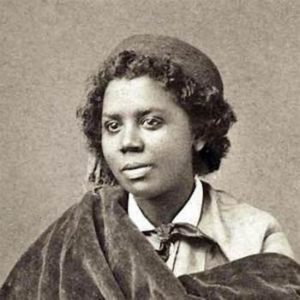
Edmonia Lewis
The birth of Edmonia Lewis is celebrated on this date in 1843. She was a mid-nineteenth-century Black artist.
She was born in the Albany, New York, area and spent most of her girlhood in Newark, New Jersey. Her mother, Catherine Mike Lewis, was of mixed-race, Mississauga Ojibwe, and African descent. She was an excellent weaver and craftswoman. Two different African American men are mentioned in different sources as her father. The first is Samuel Lewis, who was Afro Haitian and worked as a valet (gentleman's servant). Other sources say her father was the black writer Robert Benjamin Lewis.
By the time she got to college, she was economically privileged because her older brother had made a fortune in the California gold rush and "supplied her every want anticipating her wishes after the style and manner of a person of ample income." In 1859, Lewis entered Oberlin College in Ohio, where she excelled at drawing. Known as Wildfire in the Ojibwe community, Lewis changed her name to Mary Edmonia during her time at Oberlin, the name she usually used to sign her sculptures and correspondence. When a teacher at Oberlin lost some paintbrushes, Lewis was accused of the theft; she was also accused of attempted murder when two girls fell ill after drinking mulled wine, which Lewis allegedly served them. Although acquitted of both charges, she was not permitted to graduate.
In 1863, she moved to Boston, where William Lloyd Garrison introduced her to sculptor Edward Brackett, who became her first mentor. Lewis's earliest sculptures were medallions with portraits of white, antislavery leaders and Civil War heroes, which she modeled in clay and cast in plaster. Her bust of Colonel Robert Gould Shaw, completed in 1865 and owned by the Museum of Afro-American History in Boston, depicted the young Bostonian as he led the all-Black battalion, the 54th Massachusetts Volunteer Regiment, in the battle against Confederate forces. Sales of replicas of the bust enabled Lewis to travel to Italy in 1865, where she established a studio in Rome.
Lewis often drew upon her dual ancestry for insight. The Emancipation Proclamation inspired her best-known work, Forever Free (1867). The high point of Lewis's career was the completion in 1876 of The Death of Cleopatra, held by the National Museum of American Art, Washington, D.C., which created a sensation at the Philadelphia Centennial Exposition that same year. Other sculptors generally depicted Cleopatra contemplating death; Lewis showed Cleopatra seated upon her throne after death, her head thrown back. She holds the poisonous snake that has bitten her in her right hand while her left arm hangs lifelessly. This realistic portrayal ran contrary to the sentimentality about death that was prevalent at the time.
Edmonia Lewis was believed to be the first woman sculptor of African American and Native American heritage. She was reported as still living in Rome in 1911, but the date and location of her death are unknown.
Black Women in America: An Historical Encyclopedia
Volumes 1 and 2, edited by Darlene Clark Hine
Copyright 1993, Carlson Publishing Inc., Brooklyn, New York
ISBN 0-926019-61-9